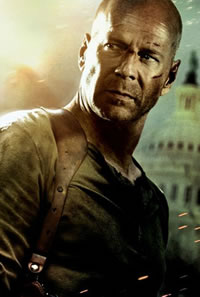 Great helicopters and explosions abound, the witticisms are barbed, and the cinematography is silver-grey in Die Hard 4.0 (or Live Free or Die Hard, depending on which empire you see it in). I was tired to start with, but the film couldn’t wake me up. I vacillated between being bored and horrified, as Bruce Willis yet again stands in for the lone American male whose first resort is always violence (in the first film he was the archetype of a Vietnam War vet, assailed by terrorists on the one hand, and a frustrating civil service bureaucracy on the other; this time he clearly represents the guy who’d go to Iraq just because it’s the right thing to do, even though he knows the government sending him is corrupt).
Great helicopters and explosions abound, the witticisms are barbed, and the cinematography is silver-grey in Die Hard 4.0 (or Live Free or Die Hard, depending on which empire you see it in). I was tired to start with, but the film couldn’t wake me up. I vacillated between being bored and horrified, as Bruce Willis yet again stands in for the lone American male whose first resort is always violence (in the first film he was the archetype of a Vietnam War vet, assailed by terrorists on the one hand, and a frustrating civil service bureaucracy on the other; this time he clearly represents the guy who’d go to Iraq just because it’s the right thing to do, even though he knows the government sending him is corrupt).
Bruce may well be caught in the middle between two kinds of bad guys—government flunkeys and monstrous villains—but this film makes it very clear where its allegiances lie: with the worship of commerce. The villain’s consistent objective seems to be to destroying the U.S. financial system, partly to take some cash for himself, partly just to show the government where it is vulnerable. He’s a public-service kind of terrorist, you see. One of the scenes that’s clearly supposed to make us feel horrified takes place on the New York stock exchange floor, when the bad guy uses a computer virus to creating a selling frenzy. I have to say that I found it difficult to muster much sympathy for rich boys freaking out at the prospect of not being so rich any more, but given that the film was paid for by Mr. Murdoch, I imagine I’m not the movie’s target demographic.
This scene, however, was not the most striking example of cynicism in Die Hard 4.0—that would be the moment where the extremely attractive Asian woman, played by Maggie Q, gets kicked and beaten by our surrogate Bruce, and eventually crushed and blown up by an SUV while Willis chuckles at having destroyed a hot chick. We’re supposed to laugh along with him.
But that’s not all—for the price of our ticket we get hatred of people who ask legitimate questions about government power, we get an air force pilot who does the wrong thing for the right reasons and therefore gets to escape with his body intact, we get a decent FBI chief who could pass for being Middle Eastern—you can almost hear the film-makers screaming, “Look at us! We’re inclusive!” We even get a propaganda speech by the tech-geek nerd/ wacky sidekick guy confessing his realization that his previous ideas about challenging authoritarianism and supporting a more equitable distribution of wealth are the kind of beliefs that lead to America being blown up by thin cheek-boned terrorists with expensive hardware. He’s an Apple geek, of course—and the computers used by the bad guys are right out of Steve Jobs’ daydreams. Willis’ character may be “a Timex watch in a digital world,” but this film is pure Microsoft—battering down the competition with a utilitarian ethic that owes more to John Wayne’s arrogant self-belief than anything resembling the beauty of being in favor of life.
Now I know I sound like a killjoy—which is, I suppose, what Bruce Willis does to a lot of people in this movie—but the question still remains:
Why is it that when we fear this kind of thing in the real world, we still want to be entertained by it?
 Gareth Higgins is a Christian writer and activist in Belfast, Northern Ireland. For the past decade he was the founder/director of the zero28 project, an initiative addressing questions of peace, justice, and culture. He is the author of the insightful How Movies Helped Save My Soul and blogs at www.godisnotelsewhere.blogspot.com
Gareth Higgins is a Christian writer and activist in Belfast, Northern Ireland. For the past decade he was the founder/director of the zero28 project, an initiative addressing questions of peace, justice, and culture. He is the author of the insightful How Movies Helped Save My Soul and blogs at www.godisnotelsewhere.blogspot.com
More from Beliefnet and our partners
